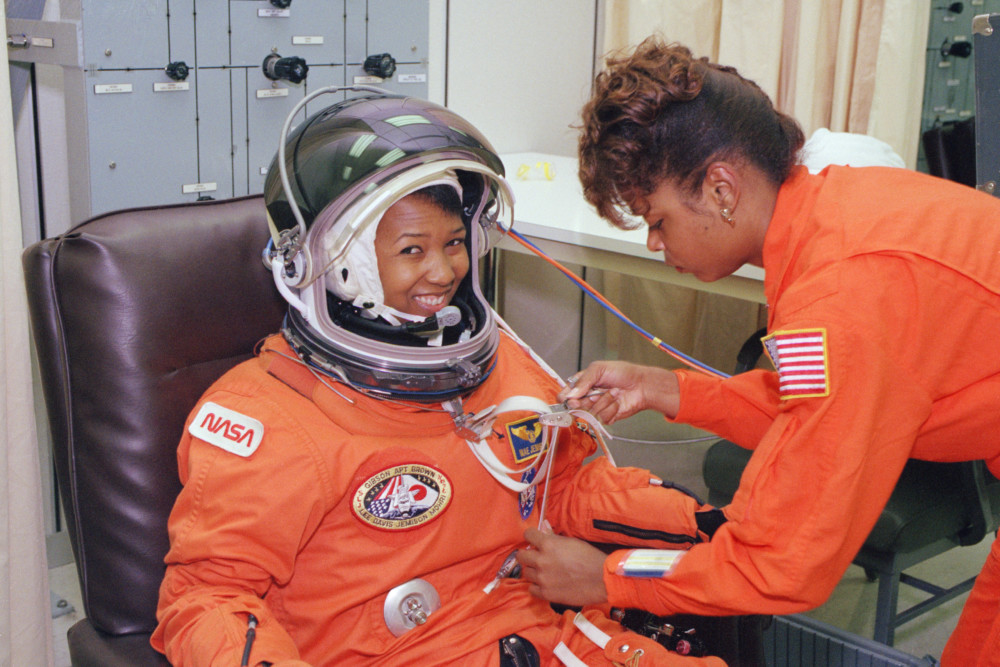By Brittani Howell
Herald-Times, Bloomington, Ind.
WWR Article Summary (tl;dr) Dr. Mae Jemison spent six years as an astronaut with NASA, flying into orbit on the space shuttle Endeavour in 1992. Her career after resigning from NASA in 1993 has been dedicated to exploring the union between physical and social science, founding science camps for children and serving as an environmental studies professor at Dartmouth College.
Herald-Times, Bloomington, Ind.
After introducing problems facing interstellar space travel, Dr. Mae Jemison — the first African-American woman to travel in space and a successful entrepreneur, physician and educator — turned to the audience in the Indiana Memorial Union Solarium Thursday evening and said, “I want you to help me design this mission.”
A nervous shift went through the audience. When students, faculty and community guests arrived at Jemison’s lecture, titled “World Peace? It’s Not Rocket Science — It’s Much, Much Harder,” they did not expect the talk to be quite so interactive. But for the next 10 minutes, they joined Jemison in voting on factors for a hypothetical space mission.
How would the ship dispose of waste? Would passengers want to stay awake during the journey, or would they rather hibernate during the 50-year trip? What would they eat?
By this point in their academic careers, most college students have given up the childhood dream of going into space. But for a few moments, everyone got the chance to think like an astronaut.
And then Jemison, quite literally, brought the discussion down to Earth: “I want all of you to stop and think about whether this is how you would answer for life here on this planet.”
As Jemison, this year’s Poling Chair of Business and Government at the Indiana University Kelley School of Business, puts it, considering the problems astronauts troubleshoot for interstellar travel is essentially “using space as a platform to see the Earth as a whole entity.” The same things required for interstellar travel, she said, are those required to survive as a species on Earth.
Jemison spent six years as an astronaut with NASA, flying into orbit on the space shuttle Endeavour in 1992. Her career after resigning from NASA in 1993 has been dedicated to exploring the union between physical and social science, founding science camps for children and serving as an environmental studies professor at Dartmouth College. With grant money she won from the Defense Advanced Research Projects Agency, Jemison headed and still leads 100 Year Starship, an initiative devoted to making human travel beyond the solar system a reality by the year 2112.
Jemison, who lived through both the mid-century civil rights era and the 1960s space race, said the space missions lost momentum as far as the public’s enthusiasm because of how homogenous the program looked. Part of her talk — and the mission of 100 Year Starship — was dedicated to making space exploration more accessible to people across the board. She said bringing in different viewpoints is a vital component of innovation, and her slide show presentation depicted men and women of different racial backgrounds from across the world.
“What happens in this world has a lot to do with who we are and who works on things,” Jemison told the audience. “There’s something important about having different perspectives, bringing people in and having them involved.”
That includes thinkers from other disciplines. Alongside the scientists and researchers from science and mathematical fields, Jemison included science fiction writers, ethnographers, social science researchers and artists.
“Life doesn’t just happen in one place,” she said. “It’s really how we express ourselves and how we interact with each other, and to do that we need the physical sciences, the social sciences and art and culture.”
For Hannah Rea, an IU sophomore studying journalism and history who wanted to be an archaeologist at NASA when she was a kid, the inclusion of the humanities was a big part of why she attended the talk.
“She’s broken a lot of ceilings that people have set, and she also does a lot of work in the arts, which I really appreciated,” Rea said. “I think she made a really good point today of bringing the arts in and seeing how important that is.”
Evelyn Harris, 7, a second-grade student at Harmony School, attended the talk with her father. She had recently read a book about Jemison and was eager to ask her whether she had been able to dance in space without gravity. (The answer: “Kind of.”) While she has not yet decided what she’s going to be when she grows up, she thought Jemison’s talk was “amazing” and said that being an astronaut isn’t off the table just yet.
But even if it is, Jemison’s talk made it clear that space is not just for astronauts and rocket scientists. It’s for anyone looking for an innovative way to examine and solve the challenges of living on Earth. She concluded her talk with a quote from astrophysicist Neil deGrasse Tyson, “We went to the moon, and we discovered Earth.”
“What will we find,” Jemison asked, “if we explore another star?”
___
(c)2016 the Herald-Times (Bloomington, Ind.)
Visit the Herald-Times (Bloomington, Ind.) at www.heraldtimesonline.com
Distributed by Tribune Content Agency, LLC.














































































































































































































































































































































































